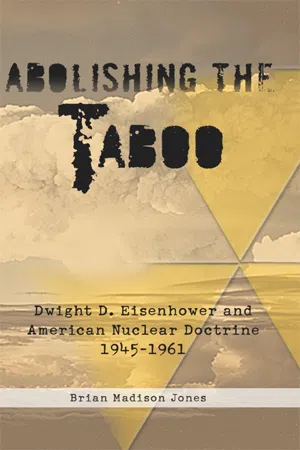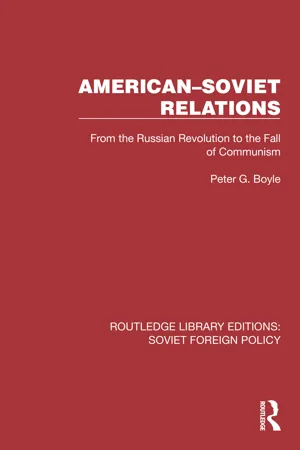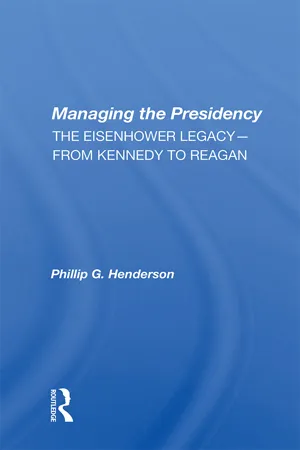History
Eisenhower Administration
The Eisenhower Administration refers to the presidency of Dwight D. Eisenhower from 1953 to 1961. It was characterized by a focus on foreign policy, including the Cold War and the establishment of the Interstate Highway System. Domestically, the administration emphasized economic prosperity and stability, often referred to as the "Eisenhower Era."
Written by Perlego with AI-assistance
Related key terms
5 Key excerpts on "Eisenhower Administration"
- eBook - ePub
Abolishing the Taboo
Dwight D. Eisenhower and American Nuclear Doctrine, 1945-1961
- Brian Madison Jones(Author)
- 2011(Publication Date)
- Helion and Company(Publisher)
17Passage contains an image b. Revisionist Scholars and Beyond
Major revision of Eisenhower scholarship began in the 1970s for two reasons.18 First, the struggles of his successors made Eisenhower and his administration look far better by comparison and thus more interesting for study.19 The growth of the power of the presidency under Lyndon Johnson, the military quagmire in South Vietnam, and the excesses of the Nixon administration, including the Watergate fiasco, forced many to take another look at the Eisenhower years. Within that context, Eisenhower simply did not look so bad anymore. “Eight years of Eisenhower: seven and a half of peace,” former Eisenhower critic Richard Rovere wrote in 1971, “ten years of Kennedy, Johnson, Nixon: almost ten solid years of war.”20 Scholars became more interested in discovering just why Eisenhower seemed to succeed and by extension why his successors seemed to fail. Second, as the Eisenhower Presidential Library and the National Archives and Records Administration began the systematic review and opening of Eisenhower’s presidential papers, scholars got a better look at just how Eisenhower governed. “The opening of his papers,” one-time Eisenhower critic Schlesinger was compelled to write, “showed that the mask of genial affability Ike wore in the White House concealed an astute, crafty, confident, and purposeful leader.”21 While they all did not agree on specifics, revisionists did agree that Eisenhower was a far more successful leader whose style was more subtle and sophisticated than previously thought. In sum, Eisenhower revisionists revealed a more active, engaged, and influential president.22 - eBook - ePub
American–Soviet Relations
From the Russian Revolution to the Fall of Communism
- Peter G. Boyle(Author)
- 2022(Publication Date)
- Routledge(Publisher)
9 The Eisenhower Era, 1953–61Eisenhower’s inauguration as president in January 1953 was followed shortly thereafter by Stalin’s death in March 1953 and the Korean armistice in July 1953. The first thaw appeared in the Cold War, which had gone through its most intense period from 1947 to 1952. Eisenhower’s presidency was marked by a succession of thaws and freezes in the Cold War, yet by 1961, as Eisenhower noted in his Farewell Address, the US–Soviet relationship of suspicion and hostility was basically unaltered and the arms race had escalated dangerously. In one sense, Eisenhower’s record was successful, since he ended the Korean War and, in a time of great peril, defended America’s interests and kept the peace at an affordable cost. In another sense, however, was Eisenhower overly cautious in his relations with the Soviet Union, with the result that opportunities for détente and disarmament were missed? This is perhaps the major question which needs to be examined with respect to US–Soviet relations in the Eisenhower era.As a war hero with a very appealing public personality, Eisenhower had powerful assets to enable him to pursue bold initiatives. On the other hand, to an even greater extent than most presidents Eisenhower was under severe political constraints, while at the same time he was not personally inclined to take any gambles on Soviet goodwill, which he believed to be virtually non-existent. Eisenhower won the presidential election in 1952 by a wide margin, but the Republicans gained control of the Senate only by the casting vote of the vice-president and held a slim majority of eight in the House of Representatives. Moreover, a serious political division existed within the Republican Party between the conservatives and moderates. Eisenhower, a moderate Republican, needed to heal the breach with conservative Republicans which had opened up with Eisenhower’s victory for the Republican nomination over the conservative Robert Taft, who became Senate Majority Leader in 1953. Moreover, McCarthy’s power was at its peak and, although Eisenhower despised McCarthy personally, he needed to avoid a confrontation with the McCarthyists, which could split the Republican Party. Against such a political background, an opening to improve relations with the Soviet Union would have been difficult even if Eisenhower had been inclined to attempt it, which essentially he was not. - eBook - ePub
Managing the Presidency
The Eisenhower Legacy--from Kennedy To Reagan
- Phillip G. Henderson(Author)
- 2019(Publication Date)
- Routledge(Publisher)
The aid to education debate captures the Cabinet at its best—as a forum for a lively and far-reaching exchange of ideas and information. As the debate developed, Eisenhower's questions remained tough, and his outlook seemed skeptical with regard to Federal intervention in an area that he viewed as a province of the states. But by debate's end, the President had been convinced to go forward with a program of aid to the states. As on many issues of the day, Eisenhower demonstrated that he was not inflexible when practical political reasoning challenged his philosophical beliefs.One of the most impressive aspects of Eisenhower's legacy in the realm of domestic policy rests with his commitment to utilize members of the Cabinet as partners in the development and implementation of policy initiatives. Although the White House staff played an important role in coordinating policy initiatives and facilitating communications with Congress and the executive departments, the staff did not take on a policy-making role. Rather, policy development remained a joint enterprise among the President, the Cabinet, and Congress.Eisenhower provided energetic and forceful leadership in rallying the departments in pursuit of his most cherished political goals, such as balancing the budget and sustaining the vitality of the mutual security program. But the President also listened carefully to his Cabinet in developing new policies, as with the aid to education program of 1959 and the renovation of the National Park system under the Mission 66 program.Domestic policy-making has taken on a dramatically different tone throughout much of the post-Eisenhower era. Increasingly, Presidents have allowed expanding White House staffs to take on actual authority in the development and even the operationalization of policy. Correspondingly the Cabinet as an advisory and administrative body has declined in importance at a time when Presidents, more than ever before, need the expertise and support of the career bureaucracy to carry out their policies. The ensuing discussion will outline the development of this problematic state of affairs in the post-Eisenhower period. - eBook - ePub
Henry M. Jackson
A Life in Politics
- Robert G. Kaufman(Author)
- 2011(Publication Date)
- University of Washington Press(Publisher)
Chapter 4 The Eisenhower Years, 1953–1961 T HE NEW D EMOCRATIC senator from Washington State returned to the nation’s capital just before the Eighty-third Congress convened in early January 1953. On the surface, the political situation looked precarious for New Deal–Fair Deal Democrats like Henry Jackson. The American people had just elected their first Republican president in twenty years. The Eisenhower landslide also gave the Republicans control of Congress, albeit by just one vote in the Senate. After twenty years in the political wilderness, conservative Republicans not only savored their party’s victory but also interpreted it as a mandate for rolling back much of the New Deal. Senator Joseph McCarthy, the new chairman of the Senate Committee on Government Operations and its investigating subcommittee, continued to pursue his reckless crusade against communists in government, real and imagined, that made even the most staunch Cold War liberals apprehensive. Beneath the surface, the long-term situation for liberal Democrats looked much better. The Eisenhower landslide had not prevented the election of several young and talented Democrats to the Senate besides Jackson: John Kennedy in Massachusetts, Mike Mansfield in Montana, and Stuart Symington in Missouri. Demographically, the New Deal coalition remained strong during the 1950s, reflected in the percentage of labor union members in the work force, the population of America’s central cities, and the numbers of self-identified ethnic voters. 1 The next eight years would disappoint conservatives who had anticipated the establishment of the Republicans as a permanent majority party. When Eisenhower left office on January 20, 1961, Cold War liberalism had experienced a resurgence as a potent political force - eBook - ePub
Modern America: A Documentary History of the Nation Since 1945
A Documentary History of the Nation Since 1945
- Robert H Donaldson(Author)
- 2014(Publication Date)
- Routledge(Publisher)
4 • The Eisenhower Administration’s “New Look” Foreign PolicyINTRODUCTION
Dwight Eisenhower’s election in 1952 brought a new foreign policy initiative to Washington; the new administration called it “New Look.” The architect of New Look was Eisenhower’s secretary of state, John Foster Dulles, an ardent anti-communist who believed with a religious zeal that the United States was the world’s moral leader and that the forces of communism represented a clear moral evil that must be contained at all costs.The administration’s New Look foreign policy reflected the Republican Party’s 1952 campaign promise to keep spending under control and balance the budget. The initiative was intended to be aggressive and engaging, but also frugal. The cornerstone of the policy was what the administration called “massive retaliation.” This strategy rejected U.S. military reliance on the expensive ground forces and conventional weapons that had been so inconclusive in Korea, in favor of an aggressive (and considerably less expensive) nuclear strategy. The policy was designed as a threat to the Soviets—a threat that Washington might respond with nuclear weapons against Soviet-sponsored aggression. “We have adopted a new principle,” Vice President Richard Nixon told the nation. “Rather than let the Communists nibble us to death all over the world in little wars, we will rely [in] the future on [our] massive mobile retaliatory powers.”The key to nuclear retaliation was, of course, weapons delivery, and in the early 1950s that meant jet aircraft with the capability of delivering the nuclear weapons, presumably, to targets in the Soviet Union. Under New Look, the Eisenhower Administration expanded the air force from 115 to 137 wings and added 300,000 troops. Delivery capability became the left arm of massive retaliation. Although air power was expensive, it still cost considerably less than ground forces (and the considerable expenditures, materiel, and manpower necessary to support those troops), and that kept costs down and budgets manageable.
Learn about this page
Index pages curate the most relevant extracts from our library of academic textbooks. They’ve been created using an in-house natural language model (NLM), each adding context and meaning to key research topics.




